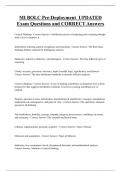MI BOLC Pre-Deployment UPDATED
Exam Questions and CORRECT Answers
Critical Thinking - Correct Answer- A deliberate process of analyzing and evaluating thought
with a view to improve it
Information ordering, pattern recognition, and reasoning - Correct Answer- The three basic
thinking abilities required for intelligence analysis
Deductive, inductive, abductive, and analogical - Correct Answer- The four different types of
reasoning
Clarity, accuracy, precision, relevance, depth, breadth, logic, significance, and fairness -
Correct Answer- The nine intellectual standards to measure effective analysis
Creative thinking - Correct Answer- A way of looking at problems or situations from a fresh
perspective that suggests unorthodox solutions. It involves creating something new or
original
Purpose, question at issue, information, interpretation & interference, concepts, assumptions,
implications & consequences, and point of view - Correct Answer- The eight basic elements
present in all thinking
Fair mindedness, humility, courage, empathy, integrity, perseverance, confidence in reason,
and autonomy - Correct Answer- The essential intellectual traits
Cultural, organizational, personal, cognitive - Correct Answer- Types of biases
Omission and assumption - Correct Answer- Types of fallacies
Indicators, key assumptions check, deception & detection, and mathematical analysis -
Correct Answer- Methods of critical thinking
, Circular response, event mapping, outside-in thinking, and brainstorming - Correct Answer-
Methods of creative thinkings
Inductive reasoning - Correct Answer- Looking at given factual information or data for a
pattern or trend and inferring the trend will continue
Deductive reasoning - Correct Answer- Using given factual information or data to infer other
facts through logical thinking
Abductive reasoning - Correct Answer- Similar to inductive reasoning since conclusions are
based on probabilities or "guessing." Because this is probably true, then this may also be true
Analogical reasoning - Correct Answer- Relies on an analogy to compare the similarities
between two specific entities; those similarities are then used to draw a conclusion - the more
similarities, the stronger the argument
Bias - Correct Answer- A preconceived notion about someone or something that obscures the
true nature of the information
Logic fallacies - Correct Answer- Errors in the reasoning process caused by the failure to
apply sound logic
Doctrine - Correct Answer- Starting point for thinking about and conducting operations
The workings of the institutional force - Correct Answer- What does doctrine not address?
Joint, multinational, multi-service, and service - Correct Answer- The four types of doctrine
Provide coherent vision of warfare, enhance operational effectiveness, provide a common
frame of reference and cultural perspective, provide common professional language, discuss
Army contributions to unified action, and state & foster desirable traits in leaders & soldiers -
Correct Answer- 6 basic contributions of doctrine
ADPs - Correct Answer- Contain fundamental principles. Operating forces and elements of
the institutional force use _____ to guide actions in support of national objectives




